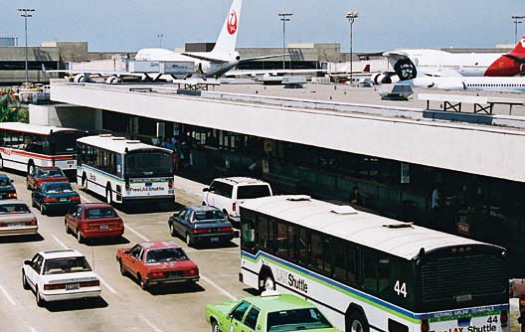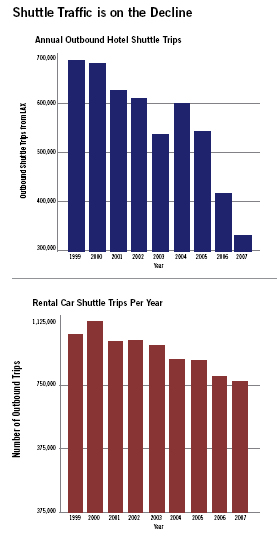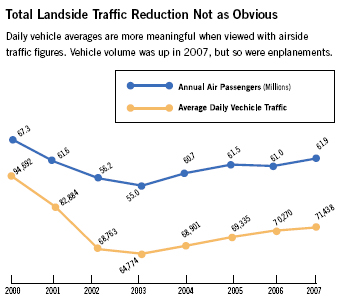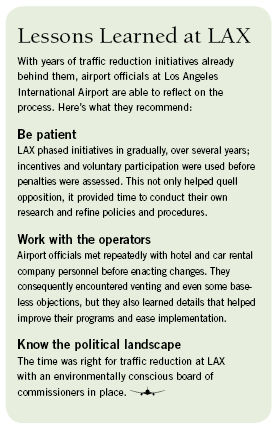Rx for Ground Congestion at LAX
If the entire city of Santa Fe, NM, drove to the Los Angeles International Airport on the same day, it would be business as usual for landside operations. The airport averages about 71,400* vehicles per day — roughly 26 million last year.

Managing such volume presents a unique set of challenges. Concerns about congestion, pollution and noise in the central terminal area prompted the airport to enact a multi-faceted traffic reduction program.
Although roughly 70% of airport traffic is private vehicles, work began on the smaller segment of commercial traffic. “It’s the population we have the most control over,” explains Pat Tomcheck, senior transportation engineer for Los Angeles World Airports. “Commercial vehicles are also much larger, generally with higher emissions.”
No More Rolling Billboards
Reduction initiatives began with the highly visible courtesy buses used by on-airport car rental companies.
“Members of our board of commissioners were concerned by rental car buses in the central terminal area with very few passengers on board,” Tomcheck notes.
Most of the companies bristled at the suggestion of reducing trips and insisted the concerns were unfounded. Many contended their customers would simply not wait any longer for shuttles. Los Angeles World Airport staff members were subsequently dispatched to manually count passengers aboard the buses.
“Some were full,” says Tomcheck, “but too many were very sparsely occupied or even empty.”
 Initial efforts limited trips during the airport’s most congested hours. The approach proved problematic, though, because that’s precisely when the most customers needed shuttle service — during prime takeoff/arrival times.
Initial efforts limited trips during the airport’s most congested hours. The approach proved problematic, though, because that’s precisely when the most customers needed shuttle service — during prime takeoff/arrival times.
A system establishing an annual limit of trips soon evolved. Each of the eight major on-airport rental companies is allotted approximately 71,000 “base” trips; a pool of additional trips is divided based on marketshare. The airport provides weekly and monthly updates of trips taken, measured by in-vehicle transponders. After a company uses its share, it is charged $10 per excess trip.
“Generating the reports is labor-intensive, but the reports help the companies budget their trips,” Tomcheck explains. “It gives them control.”
Despite a considerable amount of initial resistance, the car rental companies are reducing their trips — by 18% last year (compared to 2005). Notably, none incurred any penalties.
“They come right up to their allocations, but not a single one went over,” says Tomcheck. “I guess the reports are working.”
Next Stop: Hotel Shuttles
A different approach was taken to reduce traffic from the 46 hotels running airport shuttles. Initially, hotels were given the opportunity to save the $1.60 per trip fee by reducing their total trip volume by 35% (vs. their own 2004 levels) and eventually converting to alternative fuel vehicles.
 In July of 2007, a $10 per trip penalty was enacted for hotels not reducing trips by 15%; this February, a $5 per trip penalty was introduced for reductions from 15% to 35%. Quarterly (rather than weekly) updates are provided, due to the larger volume of participants. More frequent trip reports, however, are provided on request.
In July of 2007, a $10 per trip penalty was enacted for hotels not reducing trips by 15%; this February, a $5 per trip penalty was introduced for reductions from 15% to 35%. Quarterly (rather than weekly) updates are provided, due to the larger volume of participants. More frequent trip reports, however, are provided on request.
Although the hotels expressed much less resistance than the car rental companies, their compliance record isn’t nearly as impressive. In the first quarter penalties were assessed, 11 hotels were fined; next quarter, the offender list was down to seven. Typical fines were a few hundred dollars; one hotel, however, racked up $23,000 in penalties.
“Some see the penalties as a cost of doing business,” explains Tomcheck. “They pay extra to maintain their standard of service.”
Many companies met reduction standards by sharing shuttles with other hotels. Others outsourced the service to a private enterprise, Destination Shuttle Service.
Results of the program look promising — a 60% reduction of trips at peak in August last year vs. August of the base year (2004). Emissions were also reduced by 66%. Importantly, hotels are not reporting complaints from customers.
 With measurable results in the hotel and car rental sectors, engineers have already begun crafting a reduction program for offairport parking shuttles, which accounted for almost 700,000 trips to the central terminal area last year.
With measurable results in the hotel and car rental sectors, engineers have already begun crafting a reduction program for offairport parking shuttles, which accounted for almost 700,000 trips to the central terminal area last year.
Down at the Station
The airport is also addressing the larger population of private vehicles — mainly by optimizing its network of FlyAway stations. FlyAway stations are central hubs that bus local residents and riders from light rail, bus and train lines to and from the airport.
“They’re becoming increasingly important as more people move downtown,” notes Tomcheck.
Success at the 30-year-old Van Nuys FlyAway inspired a new location at Union Station in March 2006 and in Westwood (serving UCLA) last June. About 1.3 million passengers rode FlyAway buses in 2007; traffic is expected to increase as the Westwood and Union Station locations become more established. Top prospects for additional FlyAway stations include Irvine and Long Beach.
Parking fees are not currently being considered as a tool to reduce vehicle traffic. Similarly, a proposal for congestion pricing (collecting tolls from private vehicles as they enter the airport) also met with great concern. “The upfront costs are expensive and the queuing would be a nightmare,” notes Tomcheck.
|
|
A study by the LA Department of Transportation estimated expenses for equipment alone at $40 million to $80 million; a break-even point wasn’t projected for 10 to 15 years.
Between expansions to the FlyAway network, refinements to car and hotel shuttle initiatives and pending programs for off-airport parking shuttles, LAX intends to further reduce landside vehicle traffic.
“It’s just the right thing to do,” says Tomcheck. “I’m sure the solutions are different for every airport, but these programs are helping us make progress.” ![]()
FREE Whitepaper
PAVIX: Proven Winner for All Airport Concrete Infrastructure
International Chem-Crete Corporation (ICC) manufactures and sells PAVIX, a unique line of crystalline waterproofing products that penetrate into the surface of cured concrete to fill and seal pores and capillary voids, creating a long lasting protective zone within the concrete substrate.
Once concrete is treated, water is prevented from penetrating through this protective zone and causing associated damage, such as freeze-thaw cracking, reinforcing steel corrosion, chloride ion penetration, and ASR related cracking.
This white paper discusses how the PAVIX CCC100 technology works and its applications.








